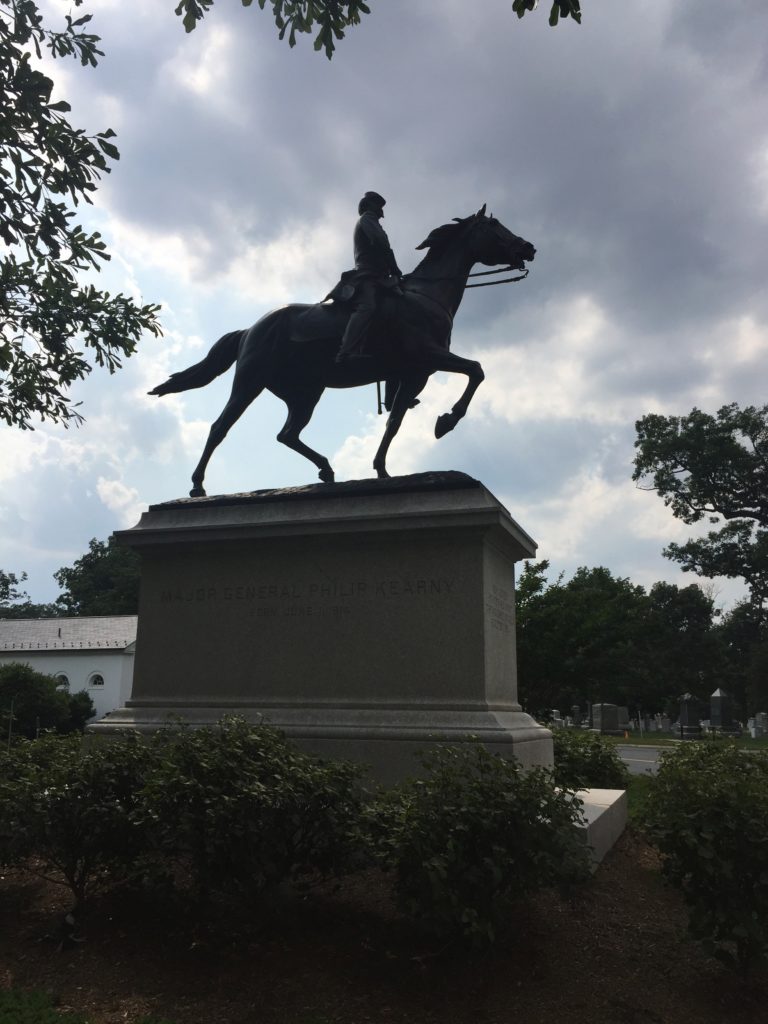Erik Visits an American Grave, Part 545
This is the grave of Phil Kearny.

Born in 1815 in New York to a pretty wealthy family (his grandfather had been a royal official in New York at the start of the American Revolution and his father was one of the founders of the New York Stock Exchange), Philip Kearny still didn’t have a great childhood. His parents died young and his guardians really did not want the young man to live his dream of going into the military. Instead, he was forced to go to law school, at Columbia, and graduated in 1833.
In 1836, Kearny’s grandfather died and he inherited a huge fortune. So he immediately quit the law for his military dream. He was named a second lieutenant of cavalry in 1837 and assigned to the 1st U.S. Dragoons, commanded by his uncle Stephen Kearny. In 1839, he was sent to France to study cavalry tactics and actually fought in several battles with the French army in Algeria, where he really did learn a lot about horse-based warfare. He returned to the U.S. in 1840 and wrote a manual about cavalry warfare for the Army. He spent quite a bit of the next few years in the West.
In 1846, Kearny resigned from the Army because he wanted to fight more. He was a pretty bloodthirsty guy it seems and had little interest in the peacetime military. But a month later, the U.S. decided to steal the northern half of Mexico to expand slavery and Kearney’s dreams could come true. He immediately reenlisted and raised a regiment of troops in Indiana under his command. The unit soon became Winfield Scott’s bodyguard. Now a captain, Kearny fought in a couple of key battles in the war, where he was shot in the arm and it had to be amputated. But excited to fight again, he almost immediately returned to active duty and was the first officer inside Mexico City when the military finally ended its march of brutalities against the Mexican people to force it to surrender.
After the war ended, Kearny struggled with the lack of killing in his life. He was a recruiter for the military for awhile, but didn’t care for it. He fought in the Rogue River War in Oregon in 1851, one of many genocidal wars of the period, but that wasn’t for very long. His marriage collapsed and he was bored. So he quit the military again. Being a rich guy who could do whatever he wanted, he decided on a worldwide tour. That was more necessary because he had met another woman and they were living together, but his first wife would not grant a divorce, though they were eventually married in 1858.
The next year, Kearny, wanting more killing, joined the French military and got to fight against the Austrians in Italy and was with Napoleon III’s imperial guard at the Battle of Solferino. For his fighting there, he was the first American granted the French Legion of Honor.
Kearny immediately returned to the U.S. at the beginning of the Civil War and was commissioned as a brigadier general. The military was initially reluctant due to his missing arm, but after the disaster at Manassas, any capable officer was of the highest priority. Kearny led men into several times and developed one very strong trait: he hated George McClellan, mostly because of the latter’s unwillingness to take the fight to the South and constant calls to retreat. In fact, Kearny frequently ignored McClellan’s orders to retreat. After McClellan ordered a retreat at the Battle of Malvern Hill, Kearney actually wrote to him: “I, Philip Kearny, an old soldier, enter my solemn protest against this order for retreat. We ought instead of retreating should follow up the enemy and take Richmond. And in full view of all responsible for such declaration, I say to you all, such an order can only be prompted by cowardice or treason.” Yet this dripping contempt did not seem to hurt his career much.
On July 4, 1862, Kearny was promoted to major general. He participated in second Manassas. As the military retreated after that disaster back toward Washington, another battle was engaged: Chantilly. No one can question Kearny’s toughness and bravery, but one can certainly question his judgement, as he let his love of fighting get in the way of common sense. He would pay dearly. He rode out by himself to investigate a hole in the lines. When he rode too far and ran into a Confederate company, he refused demands to surrender, turning around and trying to ride away. They fired and killed him. There were rumors at the time that Lincoln was considering replacing McClellan with Kearny and maybe that would have changed the war. Who knows.
Phil Kearny is buried on the confiscated lands of the traitor Lee (who in this case had Kearny’s remains and belongings shipped back to Union line), Arlington, National Cemetery, Arlington, Virginia. This was not his initial burial site. That was in East Newark, New Jersey. In 1912, one of his surviving soldiers led the campaign to get a huge grave for him and it is one of only two equestrian statue graves at Arlington.
If you would like this series to visit other Civil War generals who died in action, you can donate to cover the required expenses here. Stonewall Jackson is in Lexington, Virginia, except for his arm which is at the “shrine” in Locust Grove, Virginia, and James McPherson is in Clyde, Ohio. Previous posts in this series are archived here.


